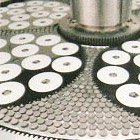Zero Waste

Basic posture 1
Zero emissions activities with due regard to economics
Our zero emissions activities reflect our intention to minimize waste destined for landfill disposal, by promoting waste recycling. The Konica Minolta Group believes it essential to give proper consideration to real-world economics while reliably implementing risk management, so as to steadily continue our zero emissions activities. In our Level 1 zero emissions criteria, therefore, we include targets for recycling and final disposal (landfill) rates, as well as for cost-cutting. We have also established stricter Level 2 zero emissions criteria. To reach Level 2, we have to meet the reduction rate targets for externally discarded waste volumes, while also striving for greater reductions in cost and risk. Characteristically, Konica Minolta' s zero emissions activities are integrated into management, from the perspective of both risk management and economy.
To fulfill our zero emissions goals, firstly we try to avoid unnecessary acquisitions, and to fundamentally reduce waste in both resources and costs. Secondly, we efficiently use all acquired resources, minimize emissions and try to reduce external emissions by implementing internal recycling. In terms of final emissions, we promote external recycling so as to reduce landfill volume to the minimum possible.
Konica Minolta Group' s zero emissions criteria

Resource recovery rate: Over 90%
Final disposal rate: Less than 5% (including secondary residue)
Cost reduction: Over 90% reduction in external payments (from fiscal 1998 levels)

Reduce volume of waste externally disposed of by 30% per sales unit (from fiscal 2001 levels)
Results of zero emissions activities:

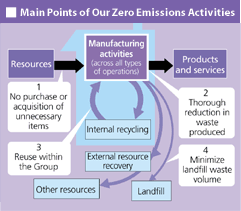
Basic posture 2
Integrated management of information on appropriate handling of waste disposal
We implement risk management to ensure that discarded waste is reliably and properly handled. For Group companies in Japan, we have established criteria for selecting waste disposal contractors. Through careful investigation, including preliminary and field surveys, we select reliable contractors who are then registered and managed in a database.
The database also includes a wide range of related information, such as illegal waste disposal, laws and regulations, environmental technologies and other knowledge accumulated within the Group. Such information is managed in an integrated manner, to ensure the most appropriate waste disposal and improve the level of zero emissions activities throughout the entire Group.
Results of resource recovery
Reducing landfill waste volume through resource recovery
In pursuing resource recovery, top priority is given to the in-house recycling of leftover materials produced in the manufacturing process. To facilitate this effort, we research and develop new recycling and production technologies.
Regarding landfill disposal, we feel that the handling of secondary residuals, those that remain after energy recovery and other recycling processes, is also the responsibility of waste producers. Accordingly, we are acutely aware of disposal volume. To reduce landfill volume we thoroughly implement waste separation and select an appropriate recycling route after checking the secondary residual volume.
As a result, in fiscal 2005 the total waste volume from Group manufacturing sites worldwide was 36,330 tons, the volume of recovered resources (the volume recycled in-house and externally) was 34,750 tons and the landfill volume was 906 tons. Thus, the resource recovery rate was 95.7% and the final disposal rate (landfill rate) was 2.5%.
Total waste volume from Group manufacturing sites in Japan for fiscal 2005 was 28,403 tons, the volume of recovered resources was 27,667 tons and the landfill volume was 148 tons. Accordingly, the resource recovery rate was 97.4% and the final disposal rate (landfill rate) was 0.5%.
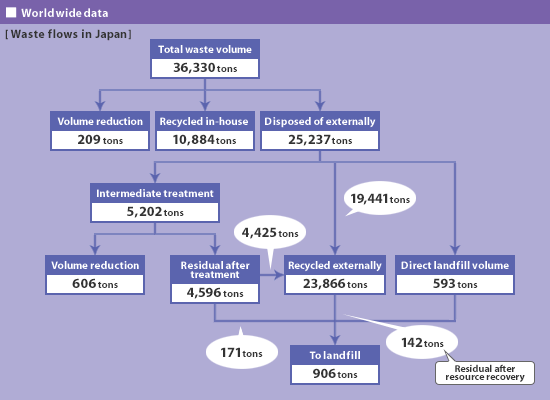
Achieving zero emission targets
Entering the next phase of zero emissions activities involving overseas business sites, now that Level 1 zero emissions have been achieved at all business sites, Level 2 at two additional sites in Japan
In fiscal 2005, two more sites achieved Level 1 criteria; all business sites in Japan have therefore attained Level 1 zero emissions. Moreover, Level 2 zero emissions has been attained by two additional sites in Japan. Worthy of special note is that Konica Minolta Glass Tech. Co., Ltd., which manufactures glass hard disk substrates, fulfilled both Levels 1 and 2 criteria at the same time. In fiscal 2006, we will expand our zero emissions activities to overseas sites, especially in China.
Sites that achieved zero emissions in fiscal 2005
Iruma Plant of Konica Minolta Glass Tech. Co., Ltd.: simultaneously achieved Levels 1 and 2 zero emissions
Konica Minolta Glass Tech greatly reduced waste emissions through in-house treatment of grinding wastewater produced in processing glass hard disk substrates. In addition, whereas defective products found in the inspection process were previously disposed of, the company now selects and re-processes such products for use as test pieces by users. Through such activities, the company achieved substantial results, satisfying both Level 1 and 2 criteria.
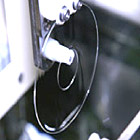
Itami Site: achieved Level 2 zero emissions
By further advancing the internal recycling of waste glass produced during the glass lens manufacturing process, while improving production efficiency the site achieved impressive results, attaining Level 2 zero emission criteria.
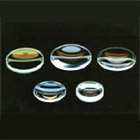
Osakasayama Site: achieved Level 1 zero emissions
In addition to reducing waste glass by improving the yield of glass hard disk substrates, the site succeeded in significantly reducing the cost of purchasing raw materials, thereby attaining Level 1 criteria.
